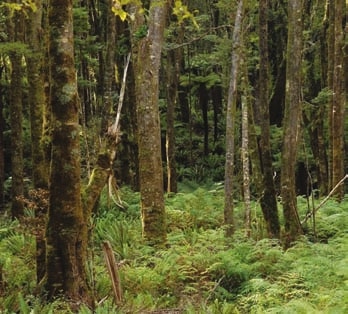Spiritual value of trees
Lynne Wallace, New Zealand Tree Grower November 2018.
An enduring memory from one of my first tramps is of walking through a large stand of beech trees, a carpet of small leaves beneath my feet and early morning rays of sunlight filtering through the branches. I still remember the feeling of peace and serenity.
More recently a place I enjoy being is on a grassy knoll with pine trees towering majestically behind me as I look across to the mixed selection of kauri, totara, rata, with blackwoods at the side.
Trees have been an important part of life from the very earliest of days with Eve taking the fruit from the forbidden tree and seducing Adam to eat it. The debate of whether the tree of life and the tree knowledge and evil are the same tree continues.
At the beginning of the creation story of the Bible all kinds of trees were grown which were pleasing to the eye and good for food. A leaf from a tree let Noah know the flood waters were receding when he had his ark full of animals.
In the Quran and sunnah there are many trees which are used as lessons to guide life.
- The date palm is a good tree which is likened the word of Tawhid when it is established in the sincere heart, where it bears fruits of good deeds that strengthen faith.
- The cedar tree is likened to a disbeliever. The believer is like that of a plant which is continually bent over by the wind, the believer is continually beset with afflictions. The example of a hypocrite is like that of the cedar tree which does not yield until it is uprooted in one go.
- The Tree of Tooba in Paradise is ‘100 years big’.
Trees are living things and each is different. Trees are symbolic of enduring strength, protection, nurture and medical. Tree roots anchor us and are a link to the past as they dive deep into the earth. Their branches spread wide and reach up to the heavens giving protection. Protection from adverse conditions. The buds, seeds and fruit offer new life and a promise for the future as well as feeding us. The trunk is seen as stable and full of strength.
In Māori mythology trees are deemed to be strong. Tane Mahuta, the ‘lord of the forest’ in Waipoua forest in particular is recognised as separating his loving parents, Ranginui, the Sky Father and Papatuanuku the Earth Mother, so their children could get light and grow. With his feet firmly against his father and his shoulders dug deeply into his mother he pushed as hard as he could to break their embrace.
Forest bathing − shinrin-yoku − which was first promoted in Japan during the 1980s to get people out of the cities and into the natural world has continued to be considered beneficial The idea was that spending time in a forest listening to the quiet or to the streams and to the birds has a positive effect on your physical and mental health. Doctors prescribe three days in the forest for people who are stressed with city living. Exercise is not necessary, just being in the forest is sufficient to reduce stress levels and increase energy, creativity and concentration.
Although areas without trees can have a thriving environment of grasses and creatures, they look barren and desolate. The very words we use to describe this type of landscape are of a negative nature.
Trees come in all shapes and sizes, tall and straight, full of branches or multi trunked but just like people they can be trained to be what we want them to be.
Trees generally are flexible and sway with the winds of time. We too like trees can snap if too much pressure is brought to bear, or we have become too inflexible. By looking at trees that have lasted for centuries we can put our daily travails into perspective.


 Farm Forestry New Zealand
Farm Forestry New Zealand